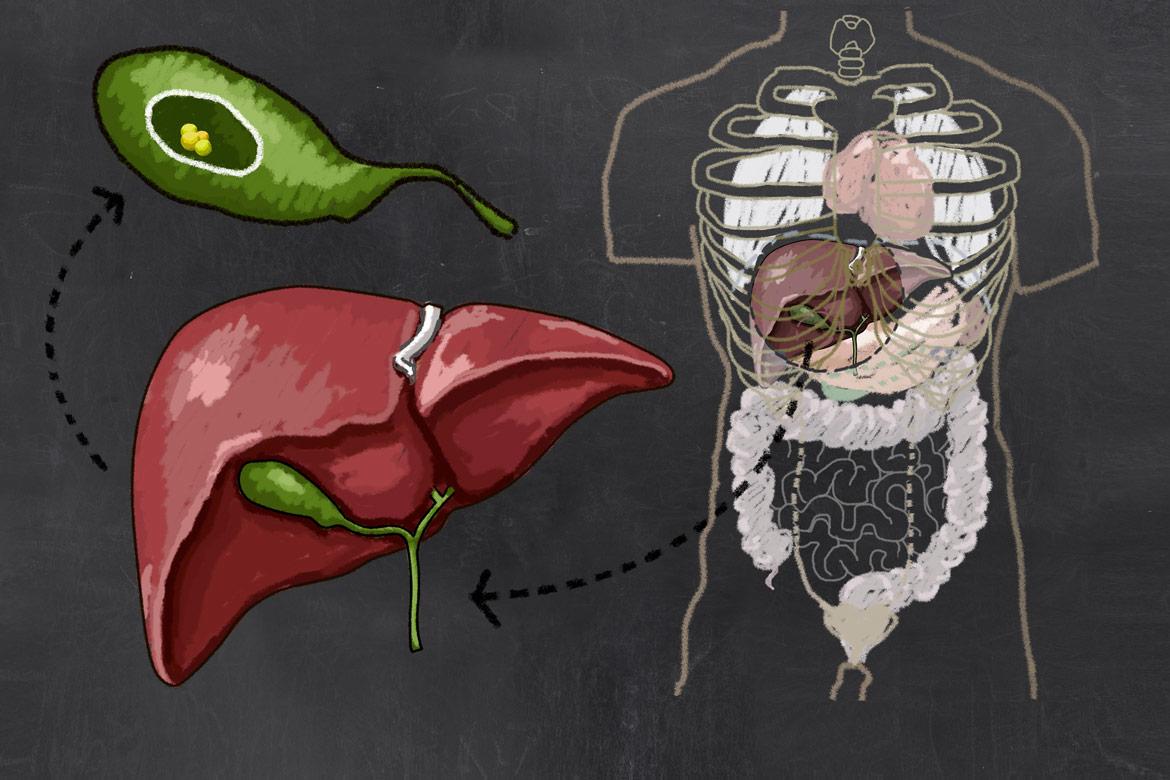
Gallstones
What are gallstones?
Gallstones are small stone-like deposits found in the gallbladder, which is a small sac-like organ that contains bile. Bile is the digestive fluid produced by the liver to break down and digest fats and is made up of cholesterol, water, fats, bile salts and bilirubin.
Gallstones are made of hardened bile, and if the bile contains high levels of cholesterol, bilirubin or bile salts, it becomes less watery and hardens into stones.
Gallstones can be present as one large gallstone that is the size of a golf ball, little stones, or a combination.
Types of gallstones
There are a few main types of gallstones:
- Cholesterol stones – This is the most common type, mainly comprised of cholesterol, lecithin and bile salts, and appears yellow-green in colour. In high concentrations, it will form cholesterol monohydrate crystals.
- Pigment stones – These are formed when there is a high level of bilirubin in the system. When combined with calcium, the stones may appear black or brown.
- Mixed stones – Over time, cholesterol or pigment stones may accumulate a proportion of calcium, producing mixed gallstones. In Asia, cholesterol or mixed stones are common.
It is possible to have a mix of cholesterol stones, pigment stones and mixed stones.
What are the symptoms of gallstones?
The symptoms of gallstones depend on how, if, and where the gallstones get blocked or lodged in. However, it is important to note that the size or number of gallstones per se is not as important as its presence, as it only takes a single stone to cause symptoms or problems.
Pain is a common symptom, which manifests in different ways. For some, it occurs in the upper right part of the abdomen or in the centre of the abdomen just below the breastbone. Others may experience it in the right shoulder or as back pain between the shoulder blades.
Other symptoms include:
- Abdominal bloating
- Burping
- Fever and chills
- Indigestion
- Jaundice
- Nausea and vomiting
The symptoms of gallstones usually occur after having a fatty and/or oily meal, and commonly at night.
Some people with gallstones do not show any symptoms, and in such cases, these are referred to as silent stones. These stones do not affect the gallbladder, liver or pancreas function.
Occasionally, gallstones may present without significant prior symptoms, with a gallstones-related complications as its first symptoms.
What are the causes of gallstones?
Gallstones are the result of an imbalance in bile and an unhealthy gallbladder. When an imbalance occurs, the high cholesterol content in bile crystalises and sticks to the walls of the gallbladder. Over time, they form gallstones which can start from grains of sand and grow to as large as a golf ball. These gallstones irritate the gallbladder and may block the gallbladder, bile ducts, liver or pancreas.
Cholesterol gallstones are caused by increased levels of cholesterol and bilirubin in the bile, as well as reduced levels of bile salts.
Pigment stones tend to occur in people who suffer from liver cirrhosis, infection of the biliary tract, and genetic blood disorders.
What are the risk factors for gallstones?
Risk factors that may increase the likelihood of gallstones include:
- Diabetes
- Cholesterol-reducing drugs
- Excess oestrogen levels
- Women (20 – 60 years old)
- Older age (above 60 years old)
- Rapid weight loss or prolonged fasting
- Family history of gallstones
- Obesity
What are the complications and related diseases of gallstones?
Gallstones can cause complications such as:
- Inflammation and infection of the gallbladder, when a gallstone is lodged in the neck of the gallbladder. Also known as cholecystitis, it can cause severe pain and fever. If severe, the gallbladder can burst (perforation) and cause widespread infection (peritonitis or sepsis), or it can die (gangrenous).
- Blockage of the common bile duct, obstructing the flow of bile from the liver to the small intestine. It can result in severe pain, jaundice or infection of the bile duct resulting in fever, chills and rigors. If severe, this can lead to potentially serious infections (sepsis).
- Blockage of the pancreatic duct, through which pancreatic juices flow. This can result in inflammation of the pancreas (known as pancreatitis) leading to intense and lasting abdominal pain that may require hospitalisation. If severe, pancreatitis can lead to serious widespread inflammation and potentially life-threatening complications including multi-organ failure, requiring admission into the intensive care unit for management.
- Gallbladder cancer, while rare, is associated with a history of gallstone formation and chronic gallbladder inflammation (known as chronic cholecystitis).
This page has been reviewed by our medical content reviewers.
Need help?
For enquiries, please call
+65 6250 0000 (Orchard) or +65 6898 6898 (Novena)
For appointment bookings, please WhatsApp
+65 8111 7777 (Orchard) or +65 8111 5777 (Novena)
 Brain & Spine Care
Brain & Spine Care




